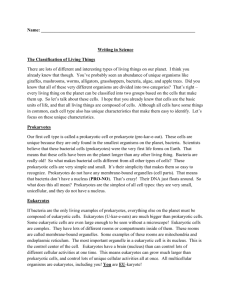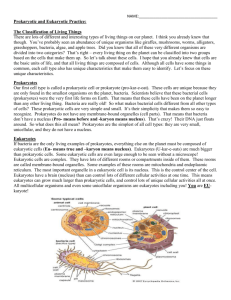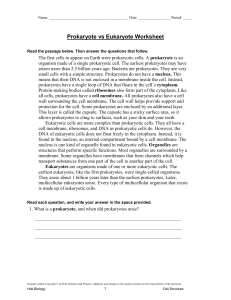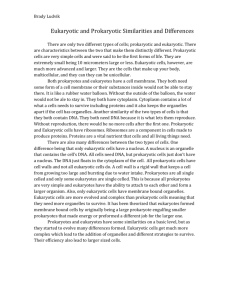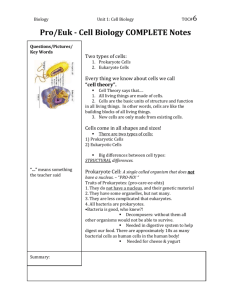Analysis Questions
advertisement
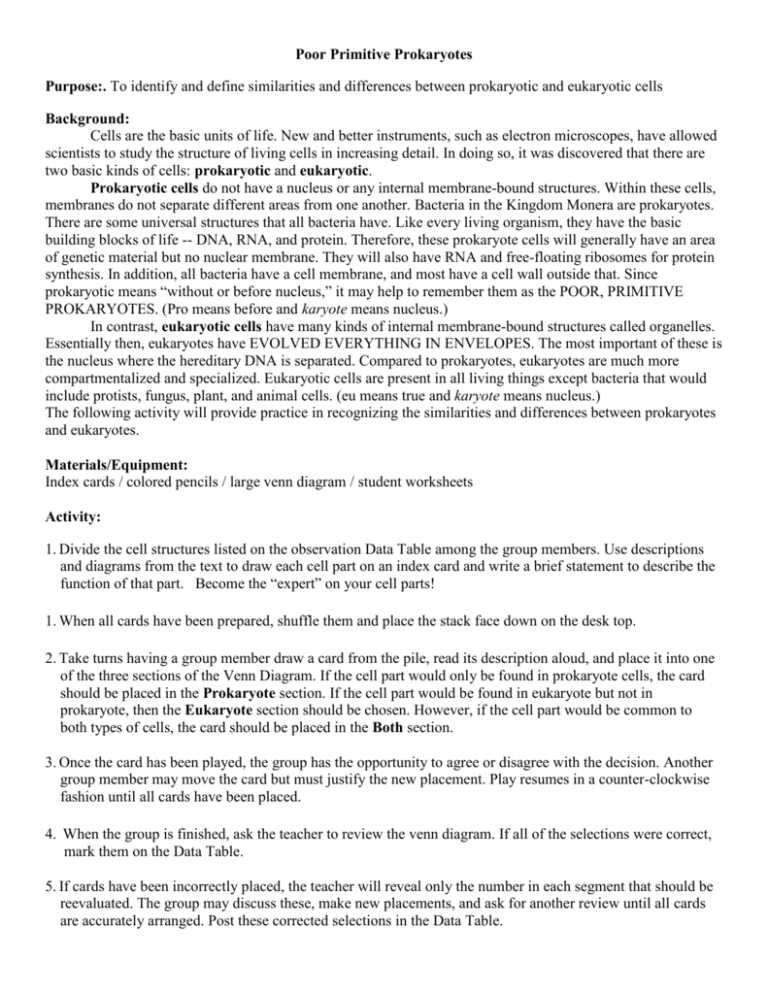
Poor Primitive Prokaryotes Purpose:. To identify and define similarities and differences between prokaryotic and eukaryotic cells Background: Cells are the basic units of life. New and better instruments, such as electron microscopes, have allowed scientists to study the structure of living cells in increasing detail. In doing so, it was discovered that there are two basic kinds of cells: prokaryotic and eukaryotic. Prokaryotic cells do not have a nucleus or any internal membrane-bound structures. Within these cells, membranes do not separate different areas from one another. Bacteria in the Kingdom Monera are prokaryotes. There are some universal structures that all bacteria have. Like every living organism, they have the basic building blocks of life -- DNA, RNA, and protein. Therefore, these prokaryote cells will generally have an area of genetic material but no nuclear membrane. They will also have RNA and free-floating ribosomes for protein synthesis. In addition, all bacteria have a cell membrane, and most have a cell wall outside that. Since prokaryotic means “without or before nucleus,” it may help to remember them as the POOR, PRIMITIVE PROKARYOTES. (Pro means before and karyote means nucleus.) In contrast, eukaryotic cells have many kinds of internal membrane-bound structures called organelles. Essentially then, eukaryotes have EVOLVED EVERYTHING IN ENVELOPES. The most important of these is the nucleus where the hereditary DNA is separated. Compared to prokaryotes, eukaryotes are much more compartmentalized and specialized. Eukaryotic cells are present in all living things except bacteria that would include protists, fungus, plant, and animal cells. (eu means true and karyote means nucleus.) The following activity will provide practice in recognizing the similarities and differences between prokaryotes and eukaryotes. Materials/Equipment: Index cards / colored pencils / large venn diagram / student worksheets Activity: 1. Divide the cell structures listed on the observation Data Table among the group members. Use descriptions and diagrams from the text to draw each cell part on an index card and write a brief statement to describe the function of that part. Become the “expert” on your cell parts! 1. When all cards have been prepared, shuffle them and place the stack face down on the desk top. 2. Take turns having a group member draw a card from the pile, read its description aloud, and place it into one of the three sections of the Venn Diagram. If the cell part would only be found in prokaryote cells, the card should be placed in the Prokaryote section. If the cell part would be found in eukaryote but not in prokaryote, then the Eukaryote section should be chosen. However, if the cell part would be common to both types of cells, the card should be placed in the Both section. 3. Once the card has been played, the group has the opportunity to agree or disagree with the decision. Another group member may move the card but must justify the new placement. Play resumes in a counter-clockwise fashion until all cards have been placed. 4. When the group is finished, ask the teacher to review the venn diagram. If all of the selections were correct, mark them on the Data Table. 5. If cards have been incorrectly placed, the teacher will reveal only the number in each segment that should be reevaluated. The group may discuss these, make new placements, and ask for another review until all cards are accurately arranged. Post these corrected selections in the Data Table. Name ________________________________________Date_________________Period ________Day_____ Poor Primitive Prokaryotes Purpose:. To identify and define similarities and differences between prokaryotic and eukaryotic cells Use the group diagram to fill in the Venn Diagram and the Data Table below. Prokaryotes Both Eukaryotes Data Table: Prokaryotes vs Eukaryotes: a Comparison of Structure Cell Type Cell Structures Prokaryote Eukaryote Both Cell Wall Cell membrane (plasma) DNA / Chromosome Nuclear Envelope (membrane) Cytoplasm Vacuoles Endoplasmic Reticulum (E.R.) Golgi Bodies Mitochondria Ribosomes Lysosomes Nucleolus 1. Using the table and references from the text, draw and label a typical prokaryotic cell and a typical eukaryotic cell. (Note: Don’t forget to include the “Both” items in your sketches.) Prokaryotic Cell Eukaryotic Cell Analysis Questions: You must write your answers in COMPLETE SENTENCES on your OWN PAPER stapled to this one. 1. Using your textbook, and the Venn Diagram, chart and your drawings, explain in detail why prokaryotic cells are considered more primitive than eukaryotic cells and are believed to be the first life on Earth. 2. Scientists have noticed that certain organelles in eukaryotes, strongly resemble the primitive prokaryote cells. Which cell parts (organelles) of the eukaryote cell look the most like an entire bacteria cell? Explain 3. DNA is the genetic code of all organisms. Compare and Contrast its form and location in both types of cells. 4. Compare the sizes of a typical Prokaryote verses a Eukaryote. 5. Which type of cell can be found both as an individual, as in a unicellular organism, or as part of a multicellular organism? 6. Give an example of a prokaryotic organism and identify the Kingdom to which all prokaryotes belong. 7. Give an example of a eukaryotic organism and identify the Kingdoms to which it could belong. Conclusion: In paragraph form and with at least 5 complete sentences, tell me what you now know about the general characteristics and structure of prokaryotes and eukaryotes.

